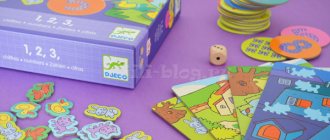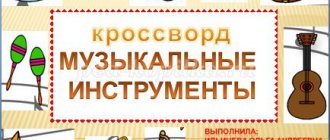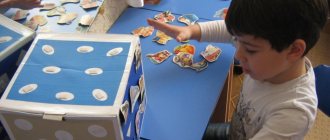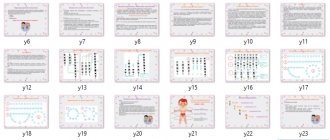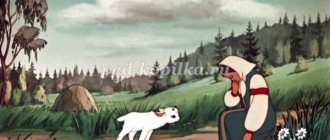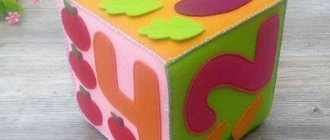Card index of board and printed games
When does this happen?
Didactic task
: To consolidate children's knowledge about the seasons. Cultivate attention, observation, partnerships.
Game rules
: Act on the teacher’s signal. Maintain the order.
Game action
: Compiling the seasons according to signs on the circles of Lull. Compiling a short story about the time of year according to signs.
Didactic material
: Lull circles for each child with story cards will be accepted.
Progress of the game
Children are given Llull circles with story cards for the seasons. Children should pick up story cards for the seasons in all circles and tell:
On the smallest circle, the state of the sun: the sun with rays, behind a cloud, without rays, etc.
On the second circle there are trees and plants according to the seasons: with leaves, with yellow leaves, snow-covered trees, etc.
In the third circle, activities for adults and children at different times of the year: swimming in the river, sledding, picking vegetables in the garden, etc.
— This time of year is summer. Because the sun is shining brightly. There are green leaves on the trees and flowers are blooming. People sunbathe and swim in the river.
— This time of year is spring. Green leaves appear on the trees. Streams run along the paths. The sun is shining, but the rays are still small. People took off their warm clothes and put on jackets and rubber boots. Etc.
What wind?
Didactic task
: To consolidate children’s knowledge about the phenomena of inanimate nature: the properties of wind.
Game rules
: Determine the positive or negative properties of the wind.
Game action:
They look at the plot picture and determine which wind is good or bad.
Didactic material
: plot pictures about the wind.
Progress of the game
The teacher displays a picture on a magnetic board. Children must determine which wind is good or bad?
— A window open from the wind, a broken vase on the floor.
— The girl cleans the room with a vacuum cleaner.
— The children are flying a kite.
— The girl calms the crying child and hands him a balloon.
— A boy launches a boat on the water.
— Strong wind in the forest and broken trees.
— There is a strong wind outside, and the children are walking in the yard.
Pick up the key
Didactic task:
To consolidate children's knowledge about the phenomena of inanimate nature: the sun, the moon, clouds.
Game rules:
Children select pictures of the corresponding color, assemble the picture and find the corresponding object from the picture. They guess riddles at the teacher’s signal.
Game action
: Collect cut-out pictures, find the corresponding object, guess riddles. Dialogue between teacher and children.
Didactic material
: cut-out pictures with the image of a key - colored, according to the number of children. Volumetric objects - keys of different shapes. A chest with riddles.
MAGAZINE Preschooler.RF
Board games in the life of a preschoolerA board game is both fun and development of certain skills at the same time.
Board games are aimed at developing the qualities necessary in our lives:
- logical thinking,
- ability to foresee a situation,
- find a way out of a difficult situation.
Board games develop children's memory and attentiveness, teach them to share, find mutual understanding with other players, resolve conflicts and not avoid problems. In the future, children who have received such social education will have the necessary skills.
There are various situations in life, and victory is not always on our side. Board games teach you to accept defeat and take it for granted. An important task is to teach a child to cope with defeat, but this is easier to do in a game than when he encounters it in real life. Acting according to the rules is also a necessary skill, because life in society is impossible without them.
Through play, a child enters the world of adults! In the game, the child receives a lesson in collective thinking for the first time. His future is connected with socially useful work, the most important quality of which is the joint, collective solution of problems aimed at achieving common goals.
In recent years, preschool educational institutions have increased attention to children's play activities.
We, educators, widely use board and printed games in practice.
Board and printed games are an interesting activity for children. They are varied in type. The developmental tasks that are solved when using them are also different.
Intellectual activity, based on active thinking and searching for ways to act, can become habitual for children already in preschool age under appropriate conditions. To successfully master the school curriculum, a child needs not only to know a lot, but also to think consistently and convincingly, to guess, and to show mental effort.
As is known, a child exhibits special mental activity when achieving a gaming goal, both in class and in everyday life. Game-based entertaining tasks are contained in various types of exciting mathematical material. Ingenuity, puzzles, and entertaining games arouse great interest among the children. Children can, without distraction, practice transforming figures for a long time, rearranging sticks or other objects according to a given pattern, according to their own ideas. In such activities, important qualities of the child’s personality are formed: independence, observation, resourcefulness, intelligence, perseverance is developed, and constructive skills are developed.
With the help of games, you can develop the child’s attention, memory, thinking, imagination, i.e. those qualities that are necessary for later life. While playing, a child can acquire new knowledge, skills, abilities, and develop abilities, sometimes without realizing it.
| Next > |
Board games for children 3-4 years old (middle group)
From the age of 3, a child already actively communicates with peers around him and is able to study and discover something together with them. At this stage, board games for children 3-4 years old can acquire new rules, and the teacher acts as an arbiter on the “field”. The joint activity is designed to develop a sense of justice - kids learn to rejoice not only in personal victory, but also in the success of their peers. The girl will be happy to enthusiastically play dress-up games, be it paper heroines with various homemade outfits or three-dimensional dolls. Dress up games can be fun not only for the sake of variety of leisure time, but also for the sake of understanding the principle and algorithm of putting on clothes. The boy will cope well with not the most complex construction set.
Those board games for children 3-4 years old that were successfully accepted by children in the younger group of kindergarten may be a little more complicated for the middle group. For example, the task set for the child will not just name the object in the picture, but give it a versatile characteristic (color, features, purpose). Develop children's speech by asking them to answer questions in detail, use facial expressions, and pronounce individual sounds.
| “My House” Children are offered separate parts of a house (door, windows, chimney, staircase) or room (sofa, chandelier, painting, refrigerator), which must be assembled into one structure. At the same time, each added detail must be voiced and reasoned. A 4-year-old child can make an arrangement using his own apartment as an example. |
| “Loto” Children are given cards with different images. From the common box, the teacher (or one of the children) takes out one chip at a time and names what is depicted on it. Kids should carefully study the cards for consistency. Whoever fills out their card correctly the fastest wins. |
| “Cubes” It is necessary to make pictures by matching all sides of the existing cubes. These are complicated puzzles. |
A series of educational board games about your hometown
Municipal preschool educational budgetary institution
“General developmental kindergarten No. 25 “Crane”
Arsenyevsky urban district
Board-printed didactic game
“In the city of Arsenyev there is...”
Author: Elena Pavlovna Vetrova, teacher of Children’s Preschool Institution No. 25 “Crane”
Arsenyev
2018
This game can be used in direct educational activities, during interaction between adults and children in restricted moments, and in independent play activities.
Name of the game:
"Loto "My city - Arsenyev"
Children's age
: 4-6 years.
Game task:
it is necessary to select part pictures for the corresponding urban object.
Didactic tasks
:
Expand children's ideas about the city, its enterprises (Arsenyevsky milk, the Cosmos cinema, the Progress cultural palace, which houses the Veselaya Arena circus studio). Continue to cultivate love for your hometown.
Develop cognitive processes: attention, memory, thinking and speech.
Rules of the game
:
1 child can participate in the 1st version of the game. He must lay out all the subject pictures on game cards;
In the 2nd version of the game, 4 children (according to the number of game cards) and the presenter can participate. The teacher may be the leader at the initial stage. Next, the role of the leader can be played by the child. Each player is dealt a game card (4 game cards in total). At the initial stage, the presenter shows a picture, talks about the place depicted on it, or the children themselves guess the place. When playing again, the children themselves name the place and talk about it. The first player to cover his entire card wins.
Progress of the game, organization of children for the game:
1. Option.
Introduction to the game.
The child is asked to look at object pictures that are placed in one pile. The teacher explains that the “Mixed Up” Wizard came and mixed everything up and that all the pictures need to be put in their places.
Option 2.
Introduction to the game.
The teacher invites the children to get acquainted with the new game (4 children participate, the rest can watch the progress of the game). Children look at game cards (fields). The teacher explains the rules of the game to the children. Participants choose a game card as desired. The teacher-leader shows the pictures one at a time. The child who has this object on the card takes the picture for himself and covers the field of the card with it.
When playing again, the role of the leader can be played by the winner or determined using a counting rhyme.
Game clarification:
In the future, game cards (fields) can be supplemented with new cards with new enterprises, that is, thereby expanding the game.
Materials used:
The pictures used in the game were found freely available on the Internet.
Photo of the game “In the city of Arsenyev there is...”
Municipal preschool educational budgetary institution
“General developmental kindergarten No. 25 “Crane”
Arsenyevsky urban district
Board-printed didactic game
"Memory"
Author: Elena Pavlovna Vetrova, teacher of Children’s Preschool Institution No. 25 “Crane”
Arsenyev
2018
This game can be used during interaction between adults and children in routine moments and in independent play activities.
Name of the game:
"Memory"
Children's age
: 5-7 years.
Game task:
find paired cards and collect as many of them as possible.
Didactic tasks
:
Expand children's ideas about the city and its attractions.
Continue to cultivate love for your hometown.
Develop children's visual memory, attentiveness, perseverance, imaginative and logical thinking.
Obey the rules of the game (keep the queue, etc.).
Rules of the game
:
The number of players is from 2 to 6 participants, depending on the number of cards.
The game is played with two identical decks of cards, with pictures on the front side.
Before the start of the game, all cards are shuffled and laid out in rows with the front side (picture) down. Players take turns opening (turning over) 2 cards. If identical cards are opened, the player takes them for himself and opens the next pair of cards. If the cards do not match, the player puts them in their original place face down and the right to move passes to the next participant. When unpaired cards are returned to their place, all players try to remember where each picture is.
The player with the most cards wins.
Progress of the game, organization of children for the game:
Children are invited to look at object pictures that depict some objects of the urban environment, name them, and talk about them. Next, the teacher invites the children to get acquainted with the new game. The teacher explains the rules of the game to the children. For the first time, the teacher can start the game first. The participant who opens two identical cards takes them for himself. When playing again, the first player is determined by a counting rhyme.
Materials used:
The pictures used in the game were found freely available on the Internet.
Municipal preschool educational budgetary institution
“General developmental kindergarten No. 25 “Crane”
Arsenyevsky urban district
Board-printed didactic game
Adventure game "City route"
Author: Elena Pavlovna Vetrova, teacher of Children’s Preschool Institution No. 25 “Crane”
Arsenyev
2018
This game can be used during interaction between adults and children in routine moments and in independent play activities.
Name of the game:
"Adventure game "City route"
Children's age
: 5-7 years.
Game task:
travel around the city, see all the sights and return back.
Didactic tasks
:
Expand children's ideas about the city and its attractions.
Continue to cultivate love for your hometown.
Develop cognitive processes: attention, thinking and speech.
Practice counting.
Obey the rules of the game (keep the queue, etc.).
Equipment:
a playing field with tracks, a cube for determining the number of moves and chips of different colors.
Rules of the game
:
The game can be played by 2 to 4 players.
You need to put chips on the “Start - “Bus Stop” sign. Players take turns and perform step-by-step actions from start to finish. On his turn, the player rolls the dice and moves his piece forward exactly as many steps as the number of points on the dice. A player's piece can move past steps occupied by other players' pieces or stop on them.
If the chip stops on a red circle, the player skips his move; if the chip stops on a green circle, then he moves along the arrow to another circle.
Progress of the game, organization of children for the game:
Introduction to the game. The teacher offers a new game: “There are many amazing places in our city, let's take a trip around our city by bus (car, bicycle). But on the road, some rules of movement are always followed.” Explains the rules of the game.
To begin, players must choose the color of their game piece and determine who will go first by rolling the dice. Then, one by one, they roll the dice and move the number of moves they roll.
Materials used:
The pictures used in the game were found freely available on the Internet.
Table: features of choosing games for children of different ages
| Age /group | Features of development | Games | Examples | Time | Notes |
| 2–2.5 (first minor) | Games must have plot pictures |
|
| Up to 5 minutes | If the regime allows (there is time before bed or before meals), then it would be good to change this activity to a more active one |
| 3–4 (second youngest) | Interest in games in pairs |
|
| 7 minutes | The work is aimed at speech development |
| 4–5 years (average) | Work in small groups (3–4 people) |
|
| 7–8 minutes | |
| 5–6 years old (older) | Conscious participation in team games |
|
| 10 minutes | Combining physical activity of an adult and a child |
| 6–7 years (preparatory) | Intolerance towards adult help |
|
| 10–12 minutes | Children learn to comment on their actions with high independence in completing tasks |
Card index of board-printed games in kindergarten
The card index of ready-made games is grouped according to the age of the children, which is reflected both in the tasks being solved and in the content of the game.
First junior group
For this category of kids, it is appropriate to use materials that involve putting together whole pictures from individual pieces, usually an even number (from 4 to 6). In addition, you need to use mosaics that develop fine motor skills. This type of game involves folding pictures based on a pattern.
Another important nuance regarding the method of playing the game: at first, the kids complete the task themselves with the help of an adult, then without an assistant. The last, most difficult stage of the work can be folding pictures at speed, but without a competitive moment. Paired or group games are not introduced in classes; each participant must have their own set of materials to avoid the possibility of quarrels.
“Who hid in the cubes?”
Tasks:
- introduce children to the main representatives of domestic and wild animals; develop the skill of combining elements into a single plot;
- increase cognitive motivation.
Instructions:
1. “Guys, here is a picture of an animal, but it has split into 4 parts. Consider them." Note: if this is not the first time that children have performed such a task, then you can ask them to name those parts of the body that are on the faces of the cube.
2. “Now try to fold the little animal. To do this, find a cube with a head on it and place the rest on it.”
3. Together with the children, we name the resulting animal.
Mosaic, geometric shapes
Tasks:
- consolidate knowledge of basic geometric shapes (square, circle, triangle, oval);
- help kids learn to correlate a verbal image with an image;
- develop attention and memory;
- cultivate persistence in work.
Instructions:
1. Children receive a set of geometric shapes and a base (cardboard or wood, plastic) with indentations. “Guys, name the shapes corresponding to each indentation.”
2. “Now find among your figures those that fit the shape on the base.”
Second junior group
In addition to the methodological subtleties characteristic of the first junior group, an element of team play is added.
Dominoes "Animals"
Tasks:
- consolidate children's knowledge about domestic or wild animals;
- teach to correlate the visual and auditory images of a word;
- develop attention, speech;
- develop the ability to work in a team.
Instructions:
1. Each child receives 4–5 dominoes.
2. The teacher places the first bone.
3. Kids take turns putting matching pictures of animals.
At this stage, you can assign tasks to complete in pairs.
“The Third Wheel” (theme “Dishes”)
Tasks:
- teach children to separate an extra element from those united by some characteristic;
- develop logical thinking;
- cultivate patience.
Instructions:
1. Children receive 3 pictures.
2. “Guys, look at the pictures, name the objects.”
3. “Which element and why is extra?”
Middle group
When working with this age group, the emphasis is on speech development. Therefore, all games involve detailed commentary along the way.
"What season?"
Tasks:
- consolidate children’s knowledge about the seasons and their defining features;
- develop speech and logical thinking.
Instructions:
1. The teacher gives the children 2-3 pictures depicting characteristic signs of a particular time of year (for example, children are making a snowman, trees are covered in snow, a janitor is clearing paths).
2. “Guys, don’t show your pictures to anyone. We will guess what is depicted on them.” Turning to the child, he asks him to describe what is drawn on the first card.
3. Whoever guessed correctly names the time of year.
4. The one who made the guess shows the picture to make sure that the season is guessed correctly.
"Paired pictures"
Tasks:
- train to find similarities and differences between two pictures, learn to select the same ones;
- develop the ability to follow the rules of the game.
Instructions:
1. The teacher takes 2 pictures that depict the same objects. He asks what it is and also gives additional information (they are the same).
2. Then the teacher gives the children 6 cards each and asks them to find pairs.
To make it more difficult, you can arrange the pictures in a column, give the kids a set of 3-4 cards and ask them to find pairs for their children in a common column.
Senior group
A distinctive feature of working with children of this age is that children need to be taught to compare objects according to a unifying characteristic.
"Numbers"
Tasks:
- teach ordinal counting from 1 to 10;
- learn to compare the number with the number of objects in the picture;
- train voluntary attention, cultivate patience.
Instructions:
1. Children receive 2-3 central blocks with images of numbers and 10 figured cards with images of objects ranging from 1 to 10.
2. Kids must connect the central block with matching shapes to make a solid circle.
Preparatory group
For this age category, it is important to choose games where the plot requires commentary.
“What does the doctor need?”
Tasks:
- generalize children’s knowledge about professions and expand knowledge about the purpose of certain work-related items;
- develop fine motor skills, speech, and the ability to logically construct statements.
Instructions:
1. There are cut pictures on the table (for example, tools).
2. Children collect entire episodes.
3. Explain the purpose of the images obtained.
Timing game plan
All elements of the educational process in kindergarten must be strictly timed. Only in this case there will be no violations of discipline, and all new information will be perceived as efficiently as possible. The game plan consists of 3 important stages:
- Introduction – 1–2 minutes. The teacher explains or reminds the rules of the game and distributes the necessary materials. If they are already prepared on the tables, then the purpose of each is explained.
- The game itself takes 3–7 minutes. The teacher helps and guides the children’s actions if necessary.
- Summing up – 1–2 minutes. At this stage, it is important to praise each participant, regardless of the success of the results of his game.
Even the lotto game is played under the supervision of an adult
An example of the timing of the game “Where can I buy this?”
When studying the topic “Shopping,” the teacher explains to the kids in which departments of the store this or that product is sold. The purpose of this game is to consolidate children’s knowledge about various products and departments of stores (grocery, hardware, etc.), develop the ability to navigate the environment, and cultivate a desire to help adults.
- Explanation of the rules: children discuss where mothers buy certain products, then the adult hands out small pictures of the products, and hangs a large poster on the wall depicting various departments of the store (2 minutes).
- Children arrange the pictures into the appropriate sections, explaining their choice (2 minutes).
- Summing up (3 minutes).
Game “Where can I buy this?” develops the preschooler’s ability to navigate the world around him
